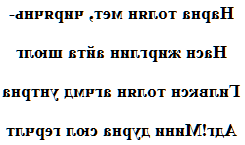Kalmyk love poem
толь
Нарна толян мет, чирячнь-
Насн жирглин айта шюлг
Гилвксн толян агчмд унтрна
Адг!Мини дурна сюл герчлт

Romanization
Toli
Narna tolyan met, chiryachn'-
Nasn zhirglin ayta shyulg
Gilvksn tolyan agchmd untrna
Adg!Mini durna syul gerchlt

→ French poem ←
Kalmyk woman
Here is the Kalmyk (possible other names : Elyut, Dorbot, Torguud, Kalmyk-Oirat, Torghut, Uriankhai, Western Mongol, Torghud, Jakhachin, Bayit, Khoton, Ööld, Weilate, Mingat, Volga Oirat, Kalmuck, Tu'erhute, Olot, European Oirat, Torgut, Dörbet, Western Mongolian, Kalmytskii Jazyk, Qalmaq, Torguut, Kalmack, Eleuth, Oirat, Khalli, Dörböd, Sart Qalmaq, Kalmuk, Oyrat, Khoshuud, Derbet, Qinghai, Torghoud, Khoshut, Hoton, Kök Nur, Buzawa, Xinjiang Mongolian, Autonym : хальмг келн (Xaľmg keln)), love poem, of the French poet Richard Bellon.
Kalmyk is a Mongolian language, of the Oïrat group, official in the Republic of Kalmykia; it is also spoken in China and Mongolia, for a total of about 170,000 speakers, but there are less than 50,000 who read and write it, and use it at home.
Kalmyk like Buryat is related to modern Mongolian. It has three dialects, Buzav, Torgut and Dörbet which is the literary language.
Kalmyk has been written for quite a long time, first with a script based on the Mongolian one, then, in Cyrillic, in Latin letters and again in Cyrillic. As there are many texts accumulated in these different scripts, to change the script is not without consequence.
The deportations of the Kalmyks to Siberia, during the Soviet era, decimated the population (nearly 1/3), and therefore the transmission of the language.
Nowadays, although Kalmyk is recognized as one of the official languages of the Republic of Kalmykia, even if there are some TV broadcasts in Kalmyk, and if its teaching has improved, it is Russian which is used almost everywhere, even the edition in Kalmyk is scarce.
Kalmyk people
Kalmykia (Elista capital) is a region of steppes, and the Kalmyks, who inhabit it, descend from the Oïrats (Oirots, Western Mongols), a set of different tribes from Mongolia to the south of the Caucasus.
At the time of Genghis Khan, they lived in the forests west of Lake Baikal. These peoples from Central Asia settled in the territory of present-day Kalmykia at the beginning of the 17th century. If traditionally they are nomadic pastoralists, they will begin to settle during the Soviet era.
Today they live, mainly in the Republic of Kalmykia (south-eastern part of the European part of the Russian Federation (west of the Volga Delta, and north-west of the Caspian)).
The prettiest girls of this ethnic group know when they dance, how the eyes of men stare at them. They do not like it too much, because if they dance, it's for other reasons. Their dance is their language, but who will know how to decipher it? Who could find the words that only them understand?